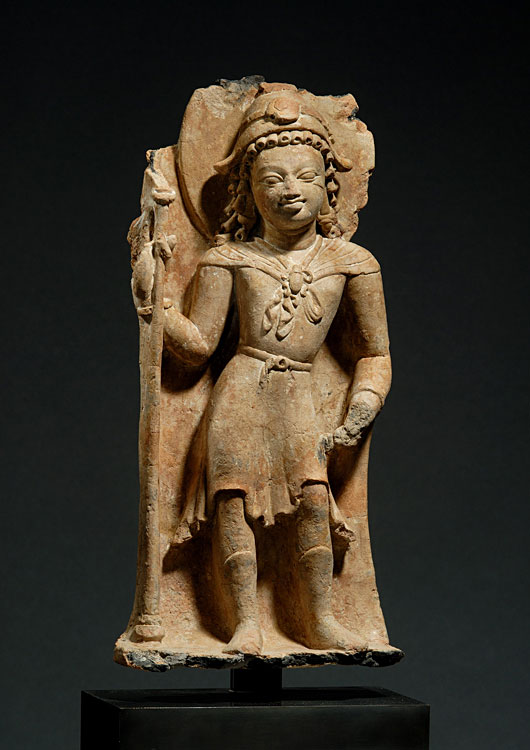

|
Kumara Bangladesh Gupta 5th/6th century Terracotta height 42 cm. |

The divine general Kumara, also known as Karttikeya or Skanda, was an important deity in northern India in the first centuries of the common era. His likeness appeared on Kushan coins and he was especially venerated by several Gupta emperors. In Hindu mythology Kumara is regarded as the son of Shiva and Parvati, an important god of war and leader of the divine armies, especially tasked with subduing troublesome demons. He bears a spear as his most distinctive attribute. Here, Kumara adopts an elegant tribhanga posture, grasping the shaft of his spear in his right hand. His left hand is lost, but may have held a kukkuta (cock). As customary, the deity is represented as a youthful figure, his divinity emphasized by a halo. He wears boots and a beautiful knee-length tunic, stylistically a Scythian costume. A capacious cloak, knotted in front, is thrust back over his shoulders. His cap, ornamented with a fillet and roundels, leaves a single row of plump curls visible. After the rise of the Gupta rulers, who in the fourth century extended their control over northern and central India as well as Bangladesh, the full flowering of classical Indian civilization took place. Among the recent discoveries by the Calcutta University Mission is an ancient site at Tamralipta. The terracottas recovered from the site reveal that the ancient port of Tamralipta was once a centre of great cultural activity. The Gupta sculptors succeeded in harmonizing the concepts of physical and spiritual wellbeing in images that served as models for the whole of Hindu and Buddhist Asia. These qualities are represented in this sculpture of Kumara. It bears all the classic stylistic characteristics – a full face with well-formed lips and open eyes, thick locks of hair falling onto the shoulders, natural volume and balance, and a clear sense of the body beneath the tunic. Indian plastic art went through a continuous period of evolution through the medium of clay. Although Kumara is a god of war, he is depicted here as an amiable figure, a young man with a handsome countenance, his eyes half closed and his mouth curved in a pleasant gentle smile. Noteworthy are the elegance of the tribhanga posture and the position of the arms, which add a hint of the dynamic breath of life. His face wears an inspired expression and his head is tilted slightly to his right. The tunic clings tightly to the body, evidencing its pure volumes. The sculpture is a rare and beautiful example of classic Gupta art. Report on Thermoluminescense Authenticity Test, c/o Department of Physics & Materials Science, City University of Hong Kong, Ref. 01195 is consistent with the period given above. Click here for full size image (1413 x 2000 pixels, 358 KB) |